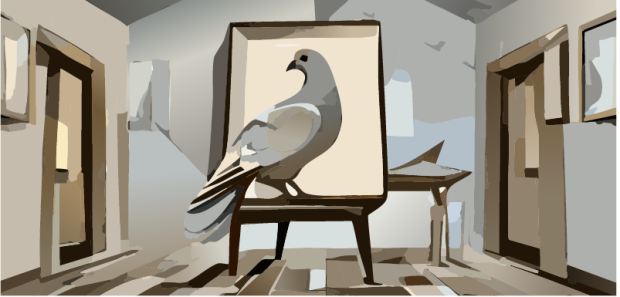Guest Post by Elizabeth G. Macalaster

(Adobe Illustrator AI-Generated Image)
When Pablo Ruiz Picasso was a young boy in Malagá, Spain, all he wanted to do was draw or cut out animals from paper. The only way his parents could convince him to attend school was to let him bring along one of the family’s pet pigeons. While the pigeon walked around his desk and cooed, Pablo drew it over and over — instead of paying attention to his lessons. Pablo also knew that with a treasured pigeon tucked under his jacket, he wouldn’t have to wait even a minute for his father to pick him up when school was done. Then he could get home and back to his drawings.
Pablo’s father, Don José Ruiz Blasco, was an artist and art teacher, and he revered pigeons, which were part of the family, flying freely through the house. Don José was Pablo’s first teacher and showed his son how to draw with precise realism. Pablo drew pigeons and human hands over and over until Don José was satisfied that he could draw accurately. When he was only nine, Pablo began sketching pigeons. He could start anywhere on the bird — its belly, its tail, its wings — and in one continuous line, draw a remarkable likeness.
Though Don José wanted to control his son’s talent and envisioned him becoming a successful academic painter, Pablo had other ideas. And at age 18, in a mark of independence from his father’s influence, Pablo stopped signing his work “Ruiz,” and instead used his mother’s last name — Picasso.
No matter what new medium Picasso explored, it always included pigeons and doves.
Pablo Picasso went on to become one of the greatest artists of the 20th century. While his father had painted scenes exactly as he saw them, Pablo surprised and even shocked the world with his art, daring people to see the world in new ways. He experimented with many different styles and materials to express his ideas. Yet no matter what new medium Picasso explored, it always included pigeons and doves. His bond with these birds had been formed as a boy and it stayed with him his entire life, inspiring his work and bringing him joy.
Picasso had witnessed the atrocities of both the Spanish Civil War and World War II, leading him to join the French Communist Party, becoming a passionate pacifist. In 1949, the artist made a lithograph of a pure white Milanese pigeon that had been given to him by his famous contemporary, Henri Matisse. The World Peace Conference was being held in Paris that year, and Picasso’s pigeon image was chosen for the poster advertising the conference.
Picasso named his daughter Paloma, Spanish for dove.
With that poster, pigeons were no longer just a fond subject for Pablo to paint or draw. His rendering of the Milanese pigeon became universally known as the dove of peace. Picasso created many more variations on this theme for other peace conferences and movements. An iconic symbol of the period, the dove was used frequently in the peace movement and as an emblem of hope during the Cold War. (That same year, 1949, Pablo’s daughter was born, and he named her Paloma, Spanish for dove.)
In 1955, Picasso moved to the South of France to La Californie, a large villa overlooking Cannes. Here, he built a dovecote so he could closely observe the daily activities of his feathered companions. Once, during a break from other work, he painted nine colorful oils of young pigeons perched in and around his Cannes studio. Pigeons and doves remained lifelong muses. In 1962, he designed a colored lithograph of a dove to advertise another peace conference in France; this “Blue Dove” is one of Pablo Picasso’s best-known works, inspiring people around the world.
NOTE: Picasso’s works are copyrighted until 2043 so images of his numerous pigeon paintings and drawings cannot be included in this article. But you can view many of his fabulous pigeon- and dove-themed pieces online here. And don’t miss this lovely 30-second Instagram video.

